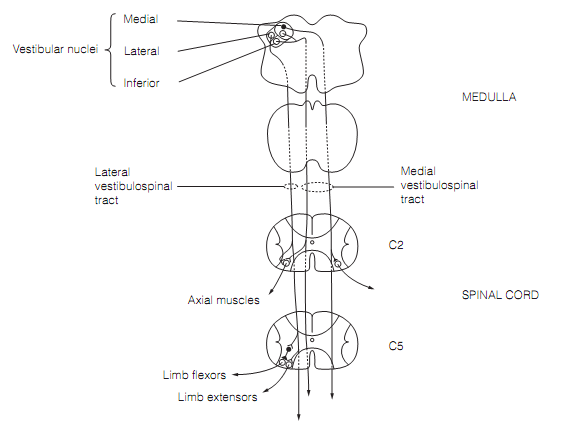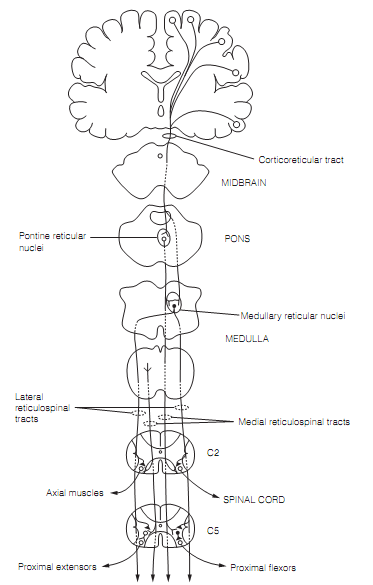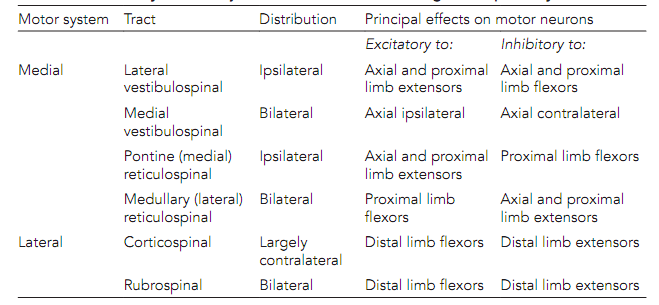Postural reflex pathways
Supraspinal descending control of the movement uses two sets of pathways. Those mediating postural reflexes that go from brainstem to spinal cord are collectively known as the medial motor pathways to differentiate them from the lateral motor pathways for making voluntary movements. The medial motor system encompasses the vestibulospinal as shown in first figure and reticulospinal tracts as shown in second figure that terminate in the intermediate and ventral gray matter of the spinal cord. Input from vestibular labyrinth goes to medial and inferior vestibular nuclei that give rise to the bilateral medial vestibulospinal tract. This makes connections with neck muscle motor neurons. In common, ipsilateral motor neurons are excited even as contralateral ones are inhibited. The pathway mediates few vestibulocollic reflexes.

Figure: The vestibulospinal tracts. The filled circles and triangles represent the cell bodies and axon terminals, correspondingly, of inhibitory neurons.

Figure: The reticulospinal tracts. The complete extent of the medial reticulospinal tracts is shown on one side only. The act of the tracts on extensors and flexors is shown on opposite sides for clarity. Triangles and filled circles are the cell bodies and axon terminals, correspondingly, of inhibitory neurons.
Vestibular afferents to the lateral vestibular nucleus are concerned in the control of limb muscles. The lateral vestibular nucleus plans through the uncrossed lateral vestibulospinal tract to all segments of the spinal cord. The Neurons in this pathway facilitate extensor motor neurons and restrain flexor motor neurons. This pathway is responsible for few vestibulospinal reflexes.
There are two reticulospinal tracts. The medial reticulospinal tract invents from the pontine reticular nuclei and is ipsilateral. The neurons excite axial and limb extensor motor neurons, though are inhibitory through polysynaptic pathways to limb flexors. The medullary reticular nuclei offer rise to the lateral reticulospinal tract that is bilateral and gives monosynaptic inhibition of neck and axial motor neurons and polysynaptic inhibition of proximal limb extensors. The medullary reticular nuclei obtain input from the mesencephalic locomotor area and project to the central pattern generators. Table below summarizes the effects of the descending motor pathways on motor neurons.
The reticular nuclei receive proprioceptor input from muscle spindles and vertebral joint receptors, and vestibular input; therefore reticulospinal tracts service both neck and vestibular reflexes. However, otolith signals for head forward and back pitching components of the vestibulocollic reflexes are not transmitted via vestibulospinal tracts though probably include the reticulospinal tracts. The reticular nuclei obtain input from the premotor cortex that permits postural reflexes to be altered by feed forward during intentional movement. Afterward lesions of the medullary reticular nuclei in cats, anticipatory adjustments are negotiated and the animals lose balance temporarily whenever attempting to move a forelimb.

Table: A summary of the major features of the descending motor pathways